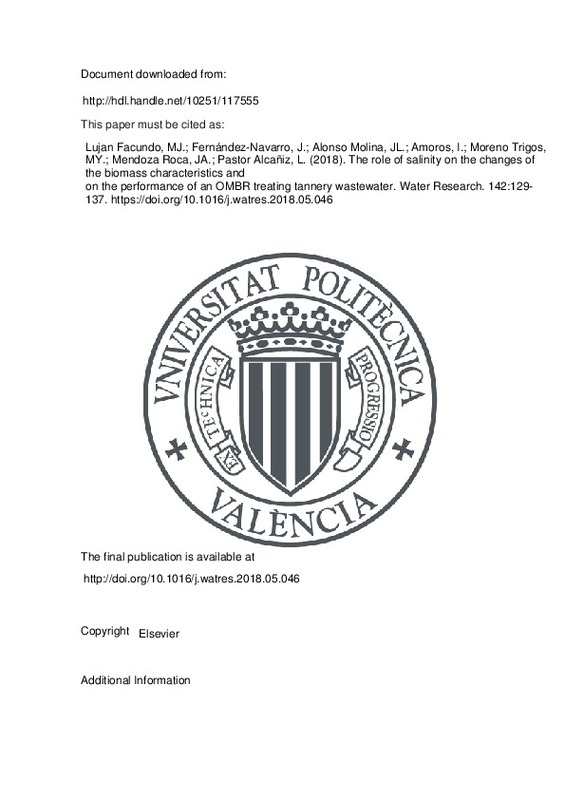JavaScript is disabled for your browser. Some features of this site may not work without it.
Buscar en RiuNet
Listar
Mi cuenta
Estadísticas
Ayuda RiuNet
Admin. UPV
The role of salinity on the changes of the biomass characteristics and on the performance of an OMBR treating tannery wastewater
Mostrar el registro sencillo del ítem
Ficheros en el ítem
| dc.contributor.author | Lujan Facundo, Maria Jose
|
es_ES |
| dc.contributor.author | Fernández-Navarro, Julián
|
es_ES |
| dc.contributor.author | Alonso Molina, José Luís
|
es_ES |
| dc.contributor.author | Amoros, Inmaculada
|
es_ES |
| dc.contributor.author | Moreno Trigos, Mª Yolanda
|
es_ES |
| dc.contributor.author | Mendoza Roca, José Antonio
|
es_ES |
| dc.contributor.author | Pastor Alcañiz, Laura
|
es_ES |
| dc.date.accessioned | 2019-03-02T21:01:28Z | |
| dc.date.available | 2019-03-02T21:01:28Z | |
| dc.date.issued | 2018 | es_ES |
| dc.identifier.issn | 0043-1354 | es_ES |
| dc.identifier.uri | http://hdl.handle.net/10251/117555 | |
| dc.description.abstract | [EN] Tannery wastewaters are difficult to treat biologically due to the high salinity and organic matter concentration. Conventional treatments, like sequential batch reactors (SBR) and membrane bioreactors (MBR), have showed settling problems, in the case of SBR, and ultrafiltration (UF) membrane fouling in the case of MBR, slowing their industrial application. In this work, the treatment of tannery wastewater with an osmotic membrane bioreactor (OMBR) is assessed. Forward osmosis (FO) membranes are characterized by a much lower fouling degree than UF membranes. The permeate passes through the membrane pores (practically only water by the high membrane rejection) from the feed solution to the draw solution, which is also an industrial wastewater (ammonia absorption effluent) in this work. Experiments were carried out at laboratory scale with a FO CTA-NW membrane from Hydration Technology Innovations (HTI). Tannery wastewater was treated by means of an OMBR using as DS an actual industrial wastewater mainly consisting of ammonium sulphate. The monitoring of the biological process was carried out with biological indicators like microbial hydrolytic enzymatic activities, dissolved and total adenosine triphosphate (ATP) in the mixed liquor and microbial population. Results indicated a limiting conductivity in the reactor of 35 mS cm(-1) (on the 43th operation day), from which process was deteriorated. This process performance diminution was associated by a high decrease of the dehydrogenase activity and a sudden increase of the protease and lipase activities. The increase of the bacterial stress index also described appropriately the process performance. Regarding the relative abundance of bacterial phylotypes, 37 phyla were identified in the biomass. Proteobacteria were the most abundant (varying the relative abundance between 50.29% and 34.78%) during the first 34 days of operation. From this day on, Bacteroidetes were detected in a greater extent varying the relative abundance of this phylum between 27.20% and 40.45%. (C) 2018 Elsevier Ltd. All rights reserved. | es_ES |
| dc.description.sponsorship | This study was supported by the Spanish Ministry of Economy and Competitiveness through the project RTC-2015-3582-5-AR. | |
| dc.language | Inglés | es_ES |
| dc.publisher | Elsevier | es_ES |
| dc.relation.ispartof | Water Research | es_ES |
| dc.rights | Reconocimiento - No comercial - Sin obra derivada (by-nc-nd) | es_ES |
| dc.subject | Forward osmosis | es_ES |
| dc.subject | Osmotic membrane biorreactor | es_ES |
| dc.subject | Tannery wastewater | es_ES |
| dc.subject | Draw solution | es_ES |
| dc.subject | Microbial community | es_ES |
| dc.subject.classification | MICROBIOLOGIA | es_ES |
| dc.subject.classification | INGENIERIA QUIMICA | es_ES |
| dc.title | The role of salinity on the changes of the biomass characteristics and on the performance of an OMBR treating tannery wastewater | es_ES |
| dc.type | Artículo | es_ES |
| dc.identifier.doi | 10.1016/j.watres.2018.05.046 | es_ES |
| dc.relation.projectID | info:eu-repo/grantAgreement/MINECO//RTC-2015-3582-5Q4618002BC.VALENCIANA/ES/Desarrollo de un proceso de biorreactor de membranas para gestión de efluentes salinos. Proyecto ODEON/ | es_ES |
| dc.rights.accessRights | Abierto | es_ES |
| dc.contributor.affiliation | Universitat Politècnica de València. Instituto de Seguridad Industrial, Radiofísica y Medioambiental - Institut de Seguretat Industrial, Radiofísica i Mediambiental | es_ES |
| dc.contributor.affiliation | Universitat Politècnica de València. Departamento de Ingeniería Química y Nuclear - Departament d'Enginyeria Química i Nuclear | es_ES |
| dc.contributor.affiliation | Universitat Politècnica de València. Departamento de Ingeniería Hidráulica y Medio Ambiente - Departament d'Enginyeria Hidràulica i Medi Ambient | es_ES |
| dc.contributor.affiliation | Universitat Politècnica de València. Instituto Universitario de Ingeniería del Agua y del Medio Ambiente - Institut Universitari d'Enginyeria de l'Aigua i Medi Ambient | es_ES |
| dc.description.bibliographicCitation | Lujan Facundo, MJ.; Fernández-Navarro, J.; Alonso Molina, JL.; Amoros, I.; Moreno Trigos, MY.; Mendoza Roca, JA.; Pastor Alcañiz, L. (2018). The role of salinity on the changes of the biomass characteristics and on the performance of an OMBR treating tannery wastewater. Water Research. 142:129-137. https://doi.org/10.1016/j.watres.2018.05.046 | es_ES |
| dc.description.accrualMethod | S | es_ES |
| dc.relation.publisherversion | http://doi.org/10.1016/j.watres.2018.05.046 | es_ES |
| dc.description.upvformatpinicio | 129 | es_ES |
| dc.description.upvformatpfin | 137 | es_ES |
| dc.type.version | info:eu-repo/semantics/publishedVersion | es_ES |
| dc.description.volume | 142 | es_ES |
| dc.identifier.pmid | 29864648 | |
| dc.relation.pasarela | S\368585 | es_ES |
| dc.contributor.funder | Ministerio de Economía y Empresa | es_ES |







![[Cerrado]](/themes/UPV/images/candado.png)

